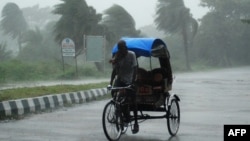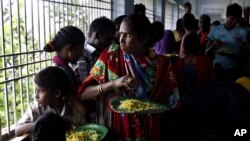NEW DELHI —
In eastern India officials are preparing a massive disaster relief operation to cope with a fierce cyclone that tore inland from the Bay of Bengal, leaving tens of thousands of people in shelters while waiting for the country's deadliest storm in over a decade to pass.
As the storm slammed the coast near Gopalpur in Orissa state Saturday night, winds with speeds of 200 kilometers per hour and incessant rain lashed the region.
Trees were uprooted, electric poles snapped and many areas were plunged into darkness as the power went off.
The chief of India’s Metrological Department, L.S. Rathore, said that the storm will continue for many hours.
“Another 24 hours rain will be there," he said. "Now it will depend as to how rain is impacting. On different terrains it will have different bearing and so and so forth and how much damage it causes.”
Officials said that the full extent of damage the cyclone causes will be difficult to assess until the morning.
Millions in storm's path
More than 10 million people live in the path of the storm in two eastern Indian states — Orissa and Andhra Pradesh.
About a half-million people living in villages along the coast were evacuated to shelters set up in schools and government buildings, while others hunkered down in their homes waiting for the cyclone to pass.
By Saturday night, reports of some deaths began trickling in. Local media reported several deaths and said that 18 fishermen were missing at sea.
The storm is expected to be less intense than a massive one which struck the region in 1999, causing widespread damage and killing 10,000 people.
Authorities say they are much better prepared to cope with the cyclone this time, but Rathore warns that the storm has massive potential for damage.
“Though with landfall, the winds will start reducing, the peak wind may be even if I presume 210-215 (kilometers per hour), every hour there will be decline till it remains (120 kilometers per hour), we definitely call it a very severe cyclone storm.”
The army, navy and air force are on standby to assist with rescue and relief operations.
Vice Chairman of the National Disaster Management Authority Marri Shashidhar Reddy said the priority is to minimize the loss of life, and that his organization has deployed about 60 rescue teams.
“The state government ... will be there with their resources; the army, they will be there with their resources," he said. "It will be on a war footing as and when things require clearing and other things.”
Tarpaulin sheets, dry food rations, medical kits and water purification tablets have been stocked in the region as officials brace for widespread power failures and flooding of roads and rail lines as the storm passes the region.
As the storm slammed the coast near Gopalpur in Orissa state Saturday night, winds with speeds of 200 kilometers per hour and incessant rain lashed the region.
Trees were uprooted, electric poles snapped and many areas were plunged into darkness as the power went off.
The chief of India’s Metrological Department, L.S. Rathore, said that the storm will continue for many hours.
“Another 24 hours rain will be there," he said. "Now it will depend as to how rain is impacting. On different terrains it will have different bearing and so and so forth and how much damage it causes.”
Officials said that the full extent of damage the cyclone causes will be difficult to assess until the morning.
Millions in storm's path
More than 10 million people live in the path of the storm in two eastern Indian states — Orissa and Andhra Pradesh.
About a half-million people living in villages along the coast were evacuated to shelters set up in schools and government buildings, while others hunkered down in their homes waiting for the cyclone to pass.
By Saturday night, reports of some deaths began trickling in. Local media reported several deaths and said that 18 fishermen were missing at sea.
The storm is expected to be less intense than a massive one which struck the region in 1999, causing widespread damage and killing 10,000 people.
Authorities say they are much better prepared to cope with the cyclone this time, but Rathore warns that the storm has massive potential for damage.
“Though with landfall, the winds will start reducing, the peak wind may be even if I presume 210-215 (kilometers per hour), every hour there will be decline till it remains (120 kilometers per hour), we definitely call it a very severe cyclone storm.”
The army, navy and air force are on standby to assist with rescue and relief operations.
Vice Chairman of the National Disaster Management Authority Marri Shashidhar Reddy said the priority is to minimize the loss of life, and that his organization has deployed about 60 rescue teams.
“The state government ... will be there with their resources; the army, they will be there with their resources," he said. "It will be on a war footing as and when things require clearing and other things.”
Tarpaulin sheets, dry food rations, medical kits and water purification tablets have been stocked in the region as officials brace for widespread power failures and flooding of roads and rail lines as the storm passes the region.












